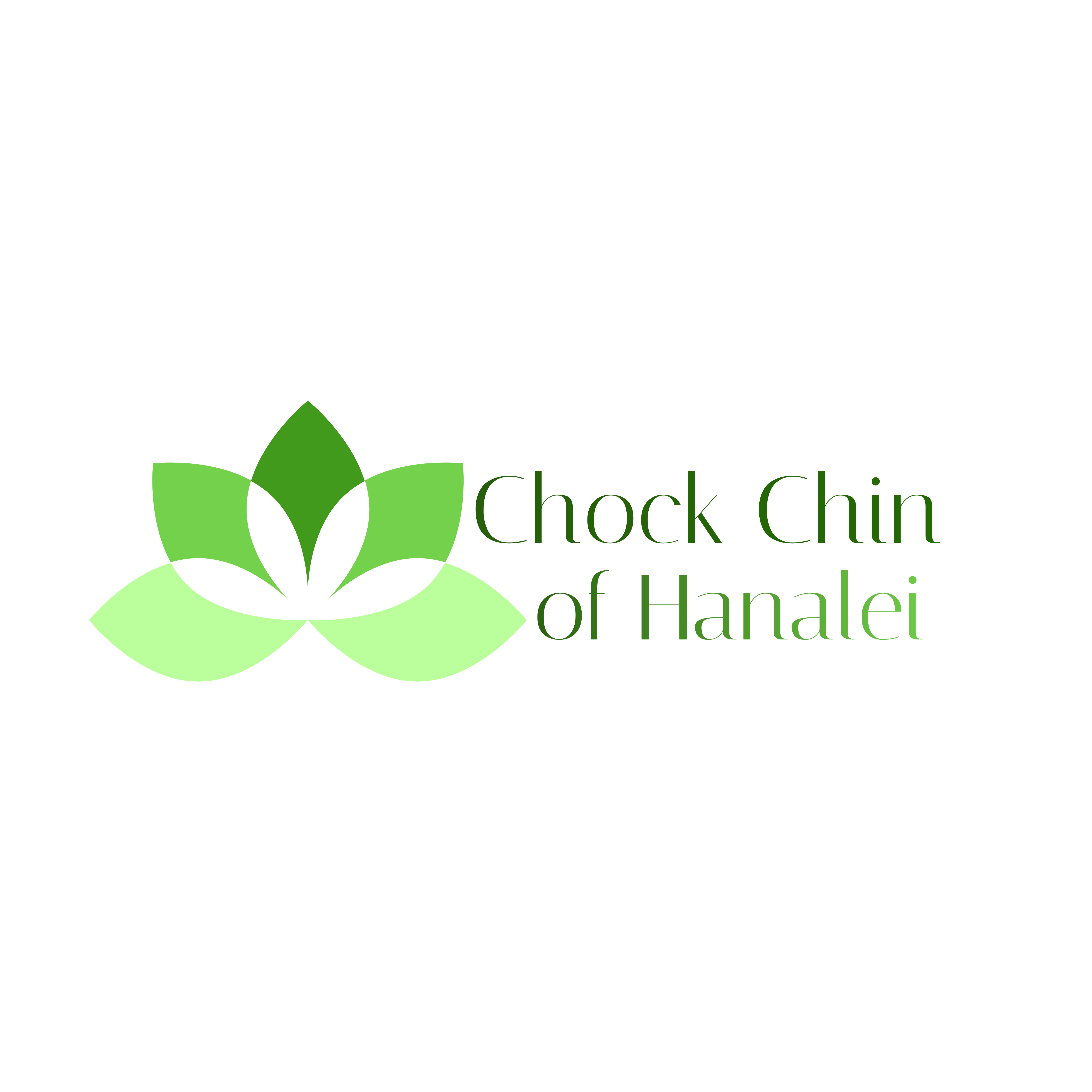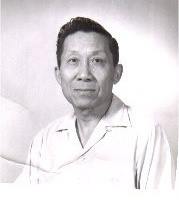
George F. Chock (Goon Fong)
Early Years
George F Goon Fong Chock was the eldest son of Chock Chin, born in Hanalei to the 2nd Chinese wife, Shee Hee, brought from China to Hanalei after he had established a business and home. (Chock Chin was always provided with wives from his ancestral home, sailing back to China to marry a new one when one of them died. If they followed the Chinese traditions, the family patriarch, Chock Chin’s father — Yung Yu- Hsuan An- Hung — would have selected each of his wives. ) Shee Hee bore five children, all of whom were delivered by Chock Chin himself. There were two older daughters, Katherine and Dorothy, and then George, and then two more sons, Kuan-chieh and Kuan-ying.
Shee Hee had a fragile constitution and tiny 4-inch bound feet, so life in the islands was very difficult for her. Her feet had been bound in anticipation of a privileged life in a traditional Chinese household, supported, dressed, carried around, cooked for, and waited on by servants. Life as the matriarch of a household in Hanalei was far from that world. Other Chinese children raised in Hawaii during this period by women who had bound feet have written about how handicapped their mothers were in the island environment, and how hard it was for them to care for the children and the domestic affairs of the household without being about to walk, run, climb, and carry things securely.
Tragedy in early childhood
In 1905, when George was about six years old, a great tragedy hit the family that was to change his life. His mother fell ill with an unnamed illness. In Dorothy’s memoirs, she recalls that the family was attempting to move her from Hanalei to Wainiha, where Chock Chin had another store, to recuperate, but she died before that could happen, at just 30 years old.

Dorothy gave a vivid account of what happened next, as documented in the memoirs of Bob Chinn (the son of Janet Chock — the youngest daughter of Chock Chin through his 3rd Chinese wife, Chun Shee).
Dorothy recalled, “At Waineha, Kauai — where Papa had one of his stores, the first of these two boys [Kuan-chieh] was being carried on the back of his nursemaid when he gave a terrible cry. The nursemaid sent me — I was about seven years old at the time — to the store to tell Papa that the devil was attacking the child. I remember running over and seeing Papa run back with a gun which he discharged in the air to drive away the devil.”
“The child died that night. The next boy [Kuan-Ying] died shortly after in a similar fashion. Papa was told by a Hawaiian kahuna that George would be next, unless we were sent away. That is when Katherine, George and I were taken to China where we stayed with Wife #1 (Chou Shee) for four years until she died in 1909.” Dorothy thinks that the two little boys died of epilepsy, but that was never officially confirmed.
Four Years in China
George and his sisters had many adventures during their four years in China. George was the youngest, but as the only son he was the heir of the family, so was safeguarded within the clan compound and must have experienced a very traditional Chinese upperclass life there — utterly unlike his Hanalei world. He did not write about these years, and never told his wife or children about his experiences, although he lived there until he was ten years old. We know they all spoke Chinese fluently by the time they returned to Hanalei — in fact they had forgotten how to speak English — and yet he did not speak or write Chinese as an adult. He seems to have suppressed, or at least compartmentalized his experiences there, the way people suppress memories of war.
This must have been a lonely, terrifying, mystifying time for these little children. Their mother and little brothers had died suddenly, horrifically, and all the adults around them believed that devils were targeting Chock Chin’s sons and George was next. They were plucked from their beautiful island home, sailed hundreds of miles away to a place foreign to them, and placed in the care of a stepmother — whose attitude toward their dead mother is not documented — and a large household of people they did not know who operated by rules they did not understand. Their father proceeded to find a new wife who was only eight years older than Katherine, and took her back home without them. I think of them standing together watching their father ride away with Chun Shee in the carriage, feeling forsaken and abandoned in a strange world with an unknown future, and wonder how that shaped their sense of permanence, security, and trust throughout their lives.
Dorothy remembers those years like this. “The Koon Tong village in which we spent four long years, was surrounded by high brick walls. At night, sentinels patrolled the narrow, unlit streets, beating on drums hourly, da kang, to notify the villagers that all was well. However, during long winter months we were in constant fear, as pirates coming nightly on sail boats would rob and plunder, causing untold destruction and suffering. Only two clans lived in our village, the Chocks and the Says. There could be no inter-marriage between the Chocks and the Says as they were of one common heritage in this village.
“During our stay in China we attended Chinese school and had received a fairly good Chinese education, enabling us to write letters in Chinese, which is now beyond my comprehension and reach since I have long forgotten the Chinese characters which I had memorized when I was a child in China.
“A dreadful epidemic of small pox broke out in our village. Young and old, including water buffaloes, the beast of burden in the Orient, were dying in great numbers. My brother George became desperately ill with it and almost lost his life. His whole body from head to toe was covered with masses of ugly, inflamed spots. As a result, pock marks remained permanently on his face. Katherine and I were immune, because we had been vaccinated while attending Hanalei School before Papa took us to China. George was too young to attend school then and so he had not been vaccinated.”
Returning Home to Hanalei
Dorothy continues, “Our sojourn in China finally terminated with the death of our stepmother, Chou Shee, in 1909. Consequently, Papa sent for us, so we sailed on the SS Mongolia from Hong Kong for Hawaii. This voyage took a month. En route the ship stopped at Shanghai, China and Yokohama, Japan. Being minors, we were not permitted to leave the ship when it was in those ports of call. ”
“Having safely arrived home in Hanalei, we three started seriously to begin the study of the English language once more, seriously trying to master it, all of which we had forgotten during the years we spent in China. George and I [Dorothy] remained in Hanalei and attended public school and graduated in 1919.”
I found an archived copy of the newspaper that documented the first graduating class of Kauai High School, the class of 1919. George was first in the class, and was named as the star of the class. He is listed under his Chinese name: Goon Fong. You can see the pictures of both George and Dorothy and the other members of the small class of seven graduates.
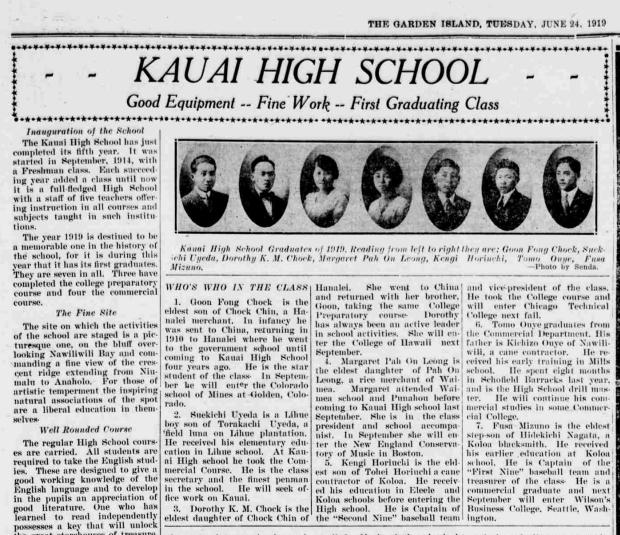
View PDF of the full newspaper page > Newspaper-24June1919-Kauai HS 1st grad class
Found here at the Library of Congress.
Education and Career
George had an outstanding intellect and was very studious. He loved learning and reading. Dorothy wrote, “When George was in high school, the young half-brothers and sisters looked forward to his coming home on vacations. The children loved to listen to the fascinating tales that he had read. One story was The Last of the Mohicans which he narrated chapter by chapter from memory.”
This love of books had been carefully nurtured by Chock Chin, who was determined that his family be well-educated and well-informed. He sent for a twenty-volume set of books called the Book of Knowledge, which was an early encyclopedia full of information about many things. Dorothy wrote: “How thankful we are that Papa bought the Book of Knowledge! There was no library in the school nor in the town. So our schoolmates enjoyed and learned from those books also. In Volume V I remember seeing pictures of snakes–fascinating and yet frightening. [Note: during this time, there were no snakes in Hawaii, so it is interesting that Dorothy was so fascinated and repulsed by the pictures of them.]
George was interested in engineering and math, and was drawn to a career as a mining engineer. He attended the Colorado School of Mines in Golden, Colorado. There was some kind of error recording his course work, so that when he had completed all his requirements and was preparing to graduate, the school notified him that he could not graduate with his class because there was one course he had not yet taken. George had plenty of proof that he had taken it and gotten the requisite “B or better” but the bureaucratic processes of the school did not move quickly enough to remedy the error before graduation. His professor had simply failed to record his grade properly.
This was the source of great heartache and disappointment to George, who had always excelled in the academic realm, and who felt this injustice most keenly. This was a time when there was still significant prejudice against Chinese Americans, and it is very possible that he felt (perhaps rightly) that this slight was due to his ethnicity. After several years elapsed, the Colorado School of Mines acknowledged their error and invited him to come and receive his degree. But he was too proud and bitter to go and accept his degree. To the end of his life, this was a subject that continued to rankle him. For him, this injustice had inflicted a wound that was so profound as to be unpardonable.
Despite those problems with his official graduation, George was able to work in the field he loved. He worked for large companies who were looking to locate promising veins of silver, gold, and other precious ore in order to develop or extend their mining operations. He traveled to remote countries to survey potential sites, assess the geological markers, take samples, and much more. As a little girl, I remember him going on long trips to Honduras for one of his employers, Piggott & Sons.
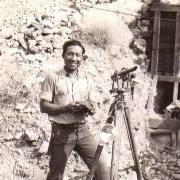
As a trained geologist, he was a fascinating companion on walks. His eyes were constantly scanning the ground for interesting rocks, and he could find geodes embedded in the ground as if he had X-Ray vision. He would come home with a pocketful of rocks and pebbles, and tell us all kinds of things about what they were, where they came from, and what had shaped them. He loved the pine forests near Mt. Shasta and Mt. Lassen near our home in Redding, California, and took the family on many day-trips to play in the woods. He was a fount of knowledge about the mountain ranges, the forces that created them, and the volcanic interiors that seethed beneath the snowy surface.
At some point he moved from the field to the desk, working as a draftsman for the City of Redding toward the end of his career.
Family
George was married twice. His first wife was Edith Elizabeth Maes, born June 14, 1906 in Havre, Chouteau, Montana. She had been married before she married George, so she brought three daughters to the marriage, Margaret, Mary Ann, and Marvel Reddington. She and George had one child together, George Gordon Chock, born 30 April 1930 in Dillon, Montana.
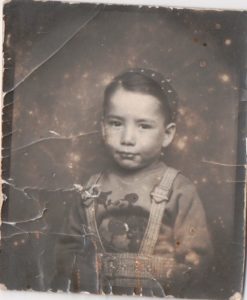
Gordon Chock – age 4
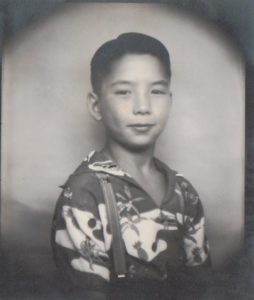
Gordon Chock – Age 7-8

Gordon and George Chock
George and Edith divorced before 1940, and she remarried Fred Evans. George got custody of Gordon for some of his high school years, and they moved to Hawaii to live with George’s sister, Dorothy and her family, and with Chun Shee in the family home in Hanalei.
George eventually met Roberta Florence Bohnker in 1949 when he was working in Kingman, Arizona. They got married on 25 November 1949 in Gallup, New Mexico. Roberta was born in 1930, making her the same age as his son, Gordon. They had four children together: three sons — Steven, Kevin and Galen — and one daughter, Susan (me).
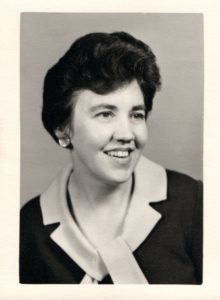
Roberta Bohnker Chock
Values and Principles
Throughout his life he cherished learning, books, ideas and word play. He enjoyed solving crossword puzzles and telling jokes that depended on double meanings. He taught us to look things up in the dictionary or encyclopedia. If we asked him what a word meant, his first response was, “Why don’t you look that up and tell me what you find.” Everywhere he sat, a small stalagmite of books, letters, newspapers, and magazines began to form. We had an intimate relationship with the City Library, and he taught us the fine points of taking care of a library book:
- Always use a bookmark
- Write down how many books you borrowed and when they are due on the calendar
- Always put the library books on a specified shelf in the hallway — that is their proper home when we are borrowing them. Then you can find all of them quickly when it’s time to go to the library.
He valued education of all kinds, and placed a high importance on musical education. I was enrolled in piano lessons before I was five, and also studied voice, choral conducting, the violin, flute, guitar and organ. My older brother, Steven, played the trombone. My youngest brother, Galen, plays the viola and sings. George himself played the ukulele and had a beautiful singing voice.
He had a strong work ethic, and a sense of pride in a job well done. He expected us to do our best in our studies, our chores, and every aspect of life. He had a rock-solid belief in personal responsibility and self-reliance. After I was grown, my mother shared that there was one year when my father was between jobs. He would not entertain any ideas about seeking any kind of assistance, but supported the family for that full year by careful management of the significant savings he had put aside.
The more I learn about his father, Chock Chin, and the way he raised his children, the more I understand where my father learned the values and principles that guided his life.
Death
George fell ill with pneumonia in 1963 and was hospitalized for some time. Upon his release, he was sent home to recuperate, but passed away on his birthday, 16 July 1963, at the age of 63 due to complications of pneumonia.
More Pictures of George F. Chock
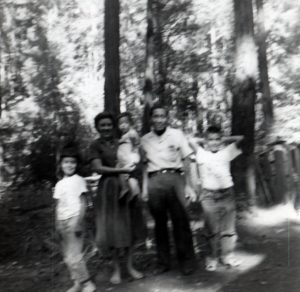

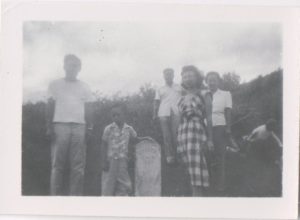
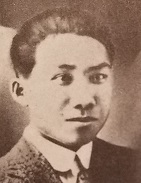
High School Graduation
